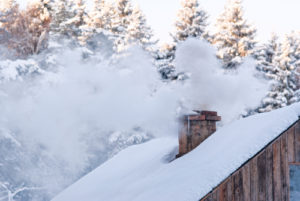Anywhere your home has seams or openings, there’s a chance for water to enter into your home and do damage. The base of your chimney is no exception. Water that finds its way in around your chimney’s base can cause severe damage to your roof and roof supports. It can lead to mold growth in your attic, and it can cause visible water damage to your ceiling and walls, such as dark spots, bubbling and peeling paint or wallpaper. Your home’s best defense against water leaks around the base of your chimney is properly installed and maintained chimney flashing.
 How chimney flashing works
How chimney flashing works
Flashing is used to seal seams all around your home. It’s used around doors and windows, and anywhere else to different home building materials come together. To prevent leaks around chimneys, flashing needs to be installed in two layers. First, a series of L-shaped metal sheets are interwoven into the shingles at the base of your chimney, with the 90-degree angle of the flashing conforming to the joint between the chimney and the roof. Next, another layer of metal sheeting is sealed against the chimney with mortar, and the metal is bent in place over the first layer of flashing. To avoid leaks around the chimney flashing, there cannot be any holes or gaps in the flashing that would allow water in. The metal sheeting must be carefully folded around the edges of the chimney. In a final step, the edges and corners of the flashing must be caulked to ensure that there are no openings that would allow water to penetrate around the chimney flashing.
How to keep your chimney flashing in good repair
Preventing leaks around your chimney flashing means ensuring that your chimney flashing remains in good repair. Just like your chimney should be inspected at least once per year, the chimney flashing should be inspected regularly for cracks, corrosion or deteriorated calking. Ask your chimney sweep about the state of your flashing during your annual chimney inspection. It’s likely that even when your flashing is in good repair, you will have to take some maintenance steps to be sure that water won’t find its way in around the flashing. The calking likely will have to be removed and replaced occasionally as it begins to break down. You also can help prevent chimney leaks by having your chimney professionally waterproofed to keep water out.
Proper chimney flashing can save your chimney — and your home — from unsightly and expensive water damage. To be sure your home is inspected, make inspecting chimney flashing part of your annual chimney inspection. If you notice signs of water creeping in around your chimneys, such as discoloration on your walls or ceiling, don’t wait for your next inspection. Call Environmental Chimney Service for proper repair, replacement or construction of your chimney flashing!
